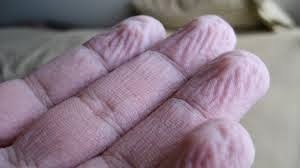The epidermis, or outer layer of the skin, is made up of cells called
keratinocytes, which form a very strong intracellular skeleton made up
of a protein called keratin. These cells divide rapidly at the bottom of
epidermis, pushing the higher cells upward. After migrating about
halfway from the bottom of this layer to the top, the cells undergo a
programmed death. The nucleus involutes, leaving alternating layers of
the cell membrane, made of lipids, and the inside, made largely of
water-loving keratin. The outer layer of the epidermis, called the
stratum corneum, is thus composed of these alternating bands.
When hands are soaked in water, the keratin absorbs it and swells. The
inside of the fingers, however, does not swell. As a result, there is
relatively too much stratum corneum and it wrinkles, just like a
gathered skirt. This bunching up occurs on fingers and toes because the
epidermis is much thicker on the hands and feet than elsewhere on the
body. (The hair and nails, which contain different types of keratin,
also absorb some water. This is why the nails get softer after bathing
or doing the dishes.)
Soaking in the tub does hydrate the skin, but only briefly. All the
added water quickly evaporates, leaving the skin dryer than before. The
oils that hold the water in have usually been stripped out by the
bath¿especially if soap and hot water are involved. But if oil is added
before the skin dries, much of the absorbed water is retained. Thus,
applying a bath oil or heavy lotion directly after a bath or shower is a
good method of hydrating the skin.

No comments:
Post a Comment